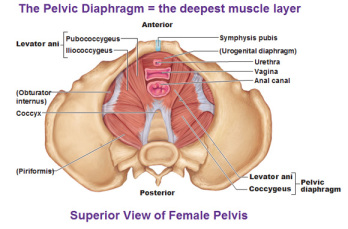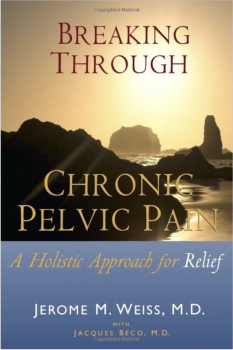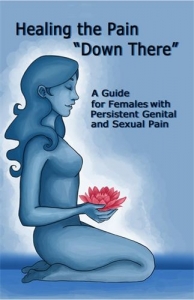Pelvic Floor Anatomy
The pelvic floor is unknown territory to most patients and, honestly, quite a few medical care providers. The pelvic floor is a fairly intricate collection of muscles which support the organs of the pelvic floor which, when dysfunctional, can contribute to a wide variety of conditions. Check out this fabulous video to learn more about the different groups and, ask yourself, where do you think your pain and discomfort is originating.
The Key Muscles You Should Know
 The pelvic floor muscles lie deep within the pelvic cavity where they support the organs of the pelvis. Distinct muscle groups extend from front to back and left to right.
The pelvic floor muscles lie deep within the pelvic cavity where they support the organs of the pelvis. Distinct muscle groups extend from front to back and left to right.
The levator ani lies at the floor of the pelvis. The pubococcygeus is the main part of the levator and runs from front to back, from the pubis towards the coccyx. This muscle can be damaged during prolonged labor and childbirth. The puborectalis forms a right and left sling in the pelvis, meeting behind the anorectal junction. The iliococcygeus is the most posterior part of the levator ani.
 The piriformus muscle extends from the sacrum to the hip bone. If it shortens or spasms due to trauma or overuse, it can compress the sciatic nerve beneath the muscle, resulting in a nerve entrapment. This is known as piriformis syndrome.
The piriformus muscle extends from the sacrum to the hip bone. If it shortens or spasms due to trauma or overuse, it can compress the sciatic nerve beneath the muscle, resulting in a nerve entrapment. This is known as piriformis syndrome.
The psoas muscle is a very long, thick muscle that extends from deep within the pelvis up into the abdominal cavity. The urogenital hiatus allows the urethra and vagina to past through and the rectal hiatus allows for the passage of the large intestine to the rectum.
Excellent Pelvic Floor Video
Additional Information
There are several good books and CD’s that will help patients understand more about the pelvic floor dysfunction, the anatomy of the pelvis and stretches and exercises that you can do at home that may help.
Breaking Through Chronic Pelvic Pain: A Holistic Approach To Treatment
 Breaking Through Chronic Pelvic Pain: A Holistic Approach to Relief is the most important book published on IC and pelvic pain in 50 years. Dr. Jerome Weiss, a urologist, pelvic pain and myofascial specialist who practiced in Northern California, devoted his career to unraveling the many potential causes for chronic bladder and pelvic pain. He shares how frustrated he was that therapies simply covered up the symptoms but did not result in healing. In his book, you will find master class in pelvic anatomy and how muscles, nerves and organs (bladder, prostate, etc.) can influence each other triggering interstitial cystitis, vulvodynia, rectal pain, overactive bladder, prostatitis and more. His caring, compassion and love for patients is shown on every page.
Breaking Through Chronic Pelvic Pain: A Holistic Approach to Relief is the most important book published on IC and pelvic pain in 50 years. Dr. Jerome Weiss, a urologist, pelvic pain and myofascial specialist who practiced in Northern California, devoted his career to unraveling the many potential causes for chronic bladder and pelvic pain. He shares how frustrated he was that therapies simply covered up the symptoms but did not result in healing. In his book, you will find master class in pelvic anatomy and how muscles, nerves and organs (bladder, prostate, etc.) can influence each other triggering interstitial cystitis, vulvodynia, rectal pain, overactive bladder, prostatitis and more. His caring, compassion and love for patients is shown on every page.
If your IC symptoms began after a trauma (i.e. a fall, surgery, having a child, etc.) he explains how the muscles and related trigger points can compress blood vessels and nerves for long periods of time. This results in poor blood flow and damage to the muscle fibers and nerves, triggering continuous pain that overwhelms the nervous system and spinal cord. While most urologists focus solely on the bladder as the source for their symptoms, he explains that bladder, vulvar, rectal sensitivity (and damage) can also be caused by muscle dysfunction via a somatovisceral reflex.
And if your symptoms began after chemotherapy, estrogen atrophy, chemical injury or infection of the bladder wall, he explains how and why muscles and nerves also become involved. And, importantly, that failure to treat each one of these systems can result in long-term suffering. He also shares how devastating stress and anxiety can be to anyone with chronic pain because it can trigger more muscle tension, more neurological dysfunction and lower pain thresholds. Proper nutrition for muscle and organ health is also discussed.
With this book, newly diagnosed patients may be able to catch muscle and nerve dysfunction early. Pay particular attention to the concept of biomechanics and how your hips, legs and feet could be driving continuous pelvic floor muscle tension and dysfunction which, when finally addressed, can result in long-term relief of many urinary symptoms. Patients with scoliosis, one leg shorter than the other, foot disorders (toes pointed inwards, toes pointed outward, Morton’s Neuroma, Morton’s toe, over pronation, etc.) will be stunned to discover that those conditions could be the root of their problems.
The book also includes very clear and detailed treatment plans. He includes dozens of patient success stories that will give you new ideas to explore with your medical team. If you are struggling with recurring flares, if bladder therapies haven’t worked well, if you are worsening rather than improving, this book is a MUST READ and will give you many more options to explore. Learn more!
DVD’s & CD’s on Pelvic Floor Dysfunction
Healing The Pain “Down There”
 New in Fall 2015 – This 4 DVD series was produced by a team of multi-disciplinary professionals (ob-gyn, pt, etc.) and an incredibly motivated patient who wanted to make a difference. Their point is simple. When you have pain “down there”, it’s very difficult to determine where the pain is coming from. This guide will not only help patients learn this, but also offers clear insight and self-help strategies for pelvic pain and pelvic floor dysfunction. Each kit also comes with a welcome guide that includes a vaginal health guide, vaginal canal map, tips for managing constipations and tips for approaching and mantaining sexual health. Learn more!
New in Fall 2015 – This 4 DVD series was produced by a team of multi-disciplinary professionals (ob-gyn, pt, etc.) and an incredibly motivated patient who wanted to make a difference. Their point is simple. When you have pain “down there”, it’s very difficult to determine where the pain is coming from. This guide will not only help patients learn this, but also offers clear insight and self-help strategies for pelvic pain and pelvic floor dysfunction. Each kit also comes with a welcome guide that includes a vaginal health guide, vaginal canal map, tips for managing constipations and tips for approaching and mantaining sexual health. Learn more!
